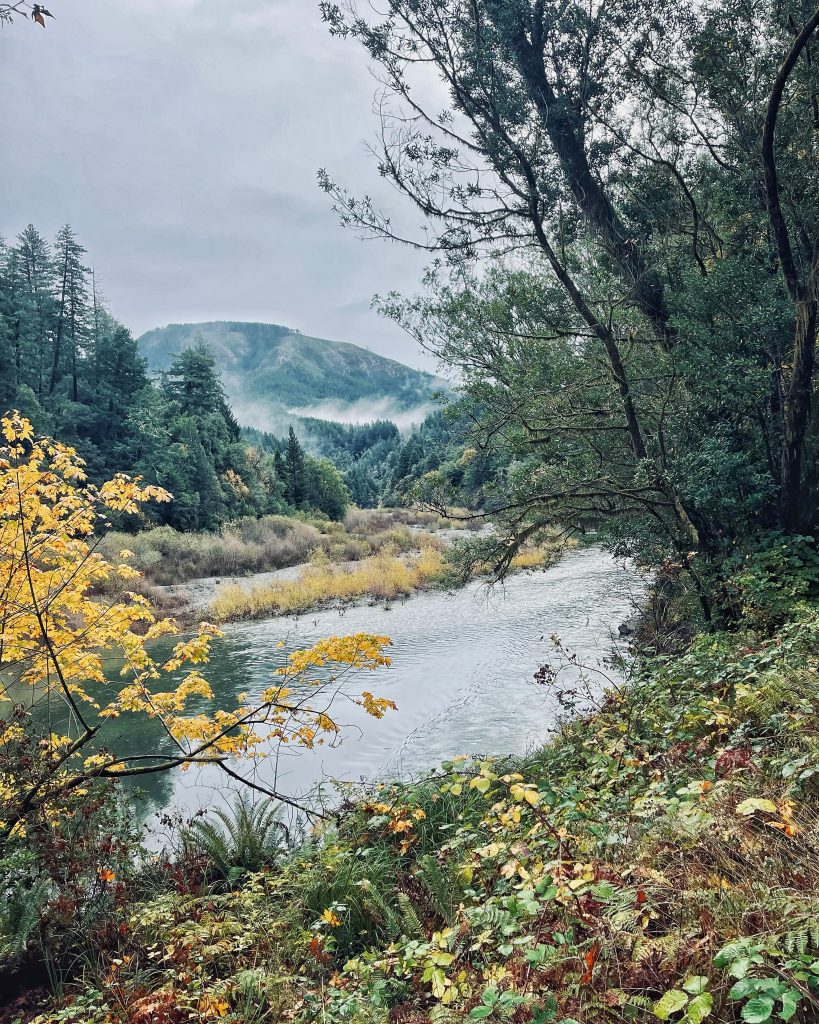
The extended excursion I recently made to southern Oregon and northern California was initially conceived as a search for lichens at Lava Beds National Monument, to take advantage of the knowledge of my friend Steve Sheehy, who has found and identified some 200 species in the monument, including one new to science (Umbilicaria nodulospora) in 2012. And I thought that as long as I was down there I’d bop on over the Siskiyous and go millipede hunting in the Medford area with my diplopod savvy friend Sam McNally. Then I realized that there were up to a dozen species of conifers in that area that aren’t found in northern Oregon/Washington, so I figured I’d spend some time crisscrossing the Klamath and Siskiyou mountains and see how many I could find. And as long as I was gonna be in the area I should (to maximize the cost/benefit ratio with gas prices being so high) head over to the coast and find and photograph redwoods and Oregon myrtle. Then maybe stop at a tidepool or two as I came north along the coast, before heading home. It seemed 6 days would do it, well maybe seven.
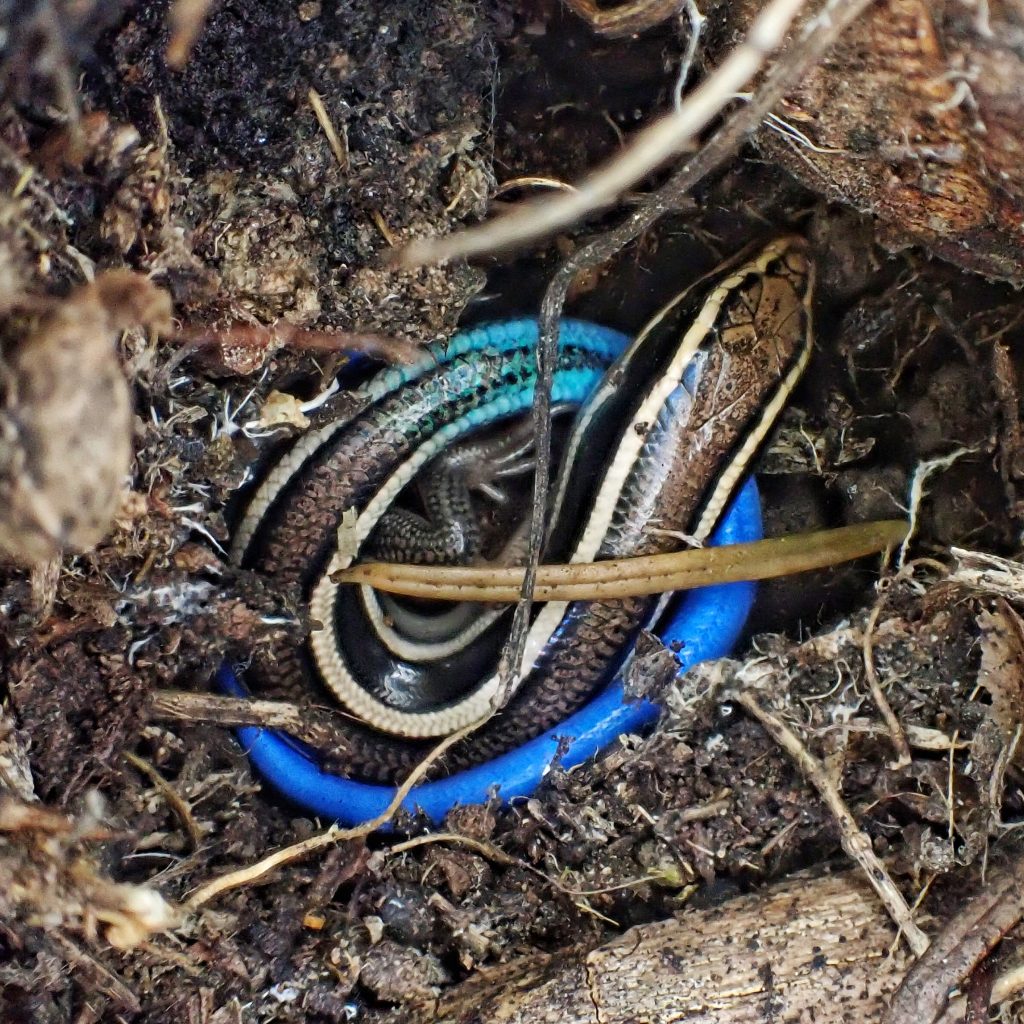
Fall and spring are the best times for finding both lichens and millipedes, because it is more humid then. Lichens are, of course, out year around, but they show off best when they are hydrated, and millipedes aren’t active on the surface at all when it is too hot and dry, or too cold. Early November seemed a perfect time, with the added benefit that conifers would have mature cones (useful for identification purposes). In the hot, dry weeks of early October I heard about an interesting fern that could be found at Hand Lake in the Cascades near Sisters, Oregon, so I decided to detour through there on my way to Lava Beds NM (which is about an hour south of Klamath Falls) and added an extra day so I could visit my friends Mike and Sue Palmer along the McKenzie River.
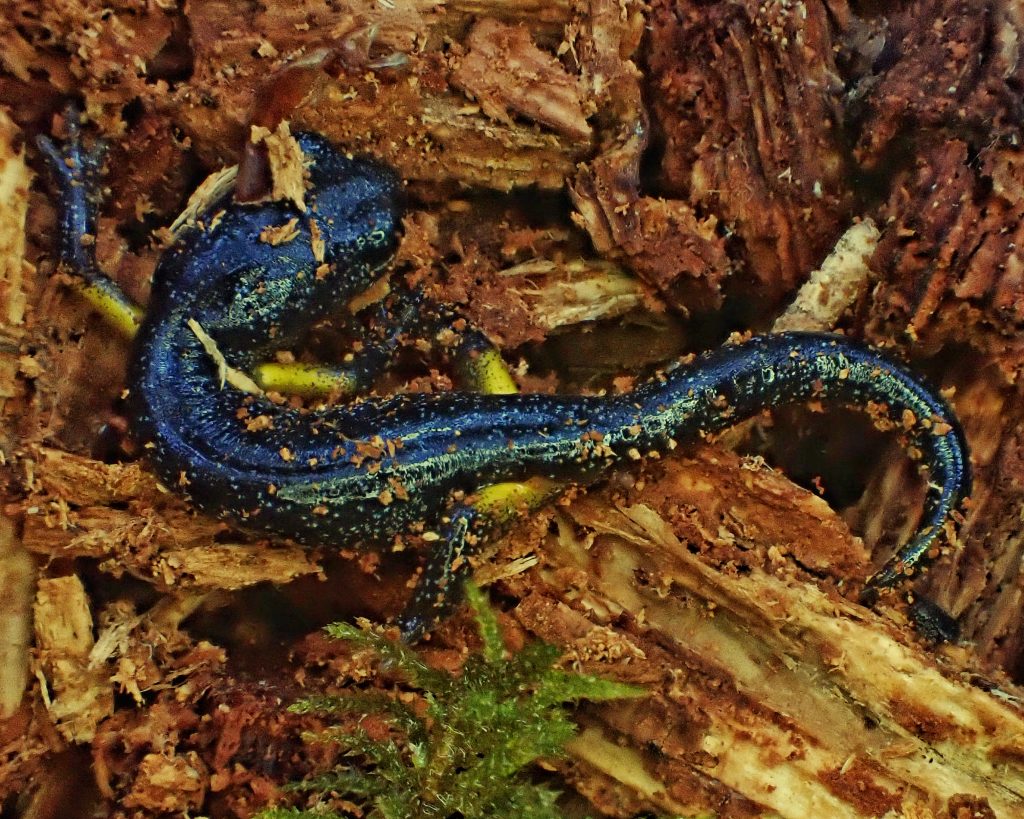
And, of course, the trip didn’t turn out anything like my original itinerary. I was forced, by the fact that winter roared in when summer had barely left, to alter my plans, and adapt my expectations. In sports terms they call it ‘taking what the defense gives you’. Psychologists call it pivoting. And it is not one of my strengths. I can, after years of practice, roll with it to some extent when misfortune strikes on a day trip. I can navigate obstacles with relative good humor, as long as a goal can be reached. But on an extended trip like this one, with the logistics of meeting people at certain times, and finding places to camp in areas that I’ve never visited before, I need a clear plan to keep my mind from spinning out. And when I saw photos of deep snow covering the lichens of Lava Beds, and making a mess of mountain travel, I seriously contemplated bagging the whole trip.
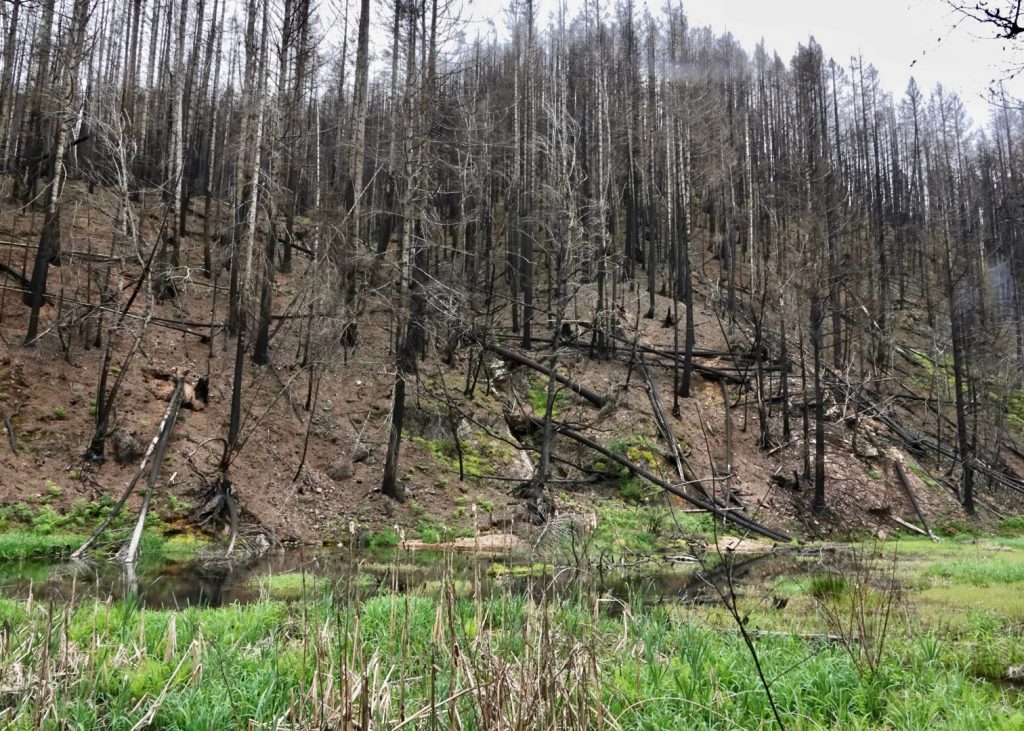
Instead, I pivoted. I decided to reverse the direction of the trip, heading to the coast first, and then working my way east. But I still wanted to visit Mike, to see the progress they’d made on rebuilding from the devastating fire, and the rejuvenation of the land itself. Both were impressive! In the spring of 2021, only a half year removed from the blaze, most of the ground away from the wetland that hadn’t been colonized by the moss Funaria hygrometrica was still blackened and bare. But now, even in November, it seemed that at least 2/3 of the ground had sprouted something. Unfortunately, the terrestrial invertebrates haven’t been as quick to return, and I saw very few as I wandered in the dark with a headlamp (but the headlamp did facilitate finding the liverwort Riccia sorocarpa), although the fact that it was a cold, rainy night in November undoubtedly contributed to that lack.
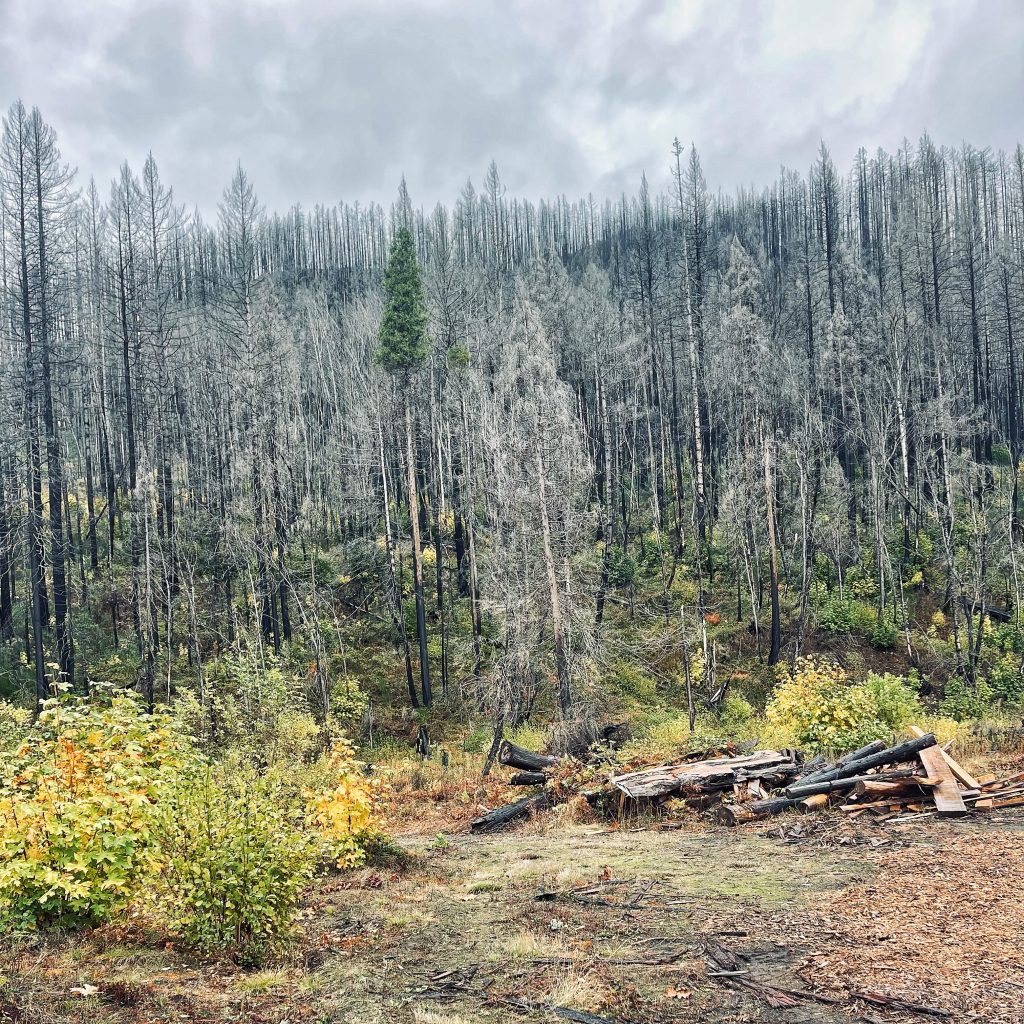
The next morning I headed west on Hwy 126, filling up in Veneta with the last sub $5 a gallon gas I’d see for the next 600+ miles. It was raining hard enough that when I stopped to walk along Wildcat Creek (a tributary to the upper Siuslaw River) I was unwilling to expose my non-waterproof camera to the elements. The presence of several vehicles occupied by hunter’s orange clad people (oddly the only obvious hunters I saw on this trip) also put a damper on my enjoyment (dressed in browns and grays as I was), so I soon quit that locale and made for the coast, though the stormy weather and high tide there didn’t make beachcombing an attractive proposition.
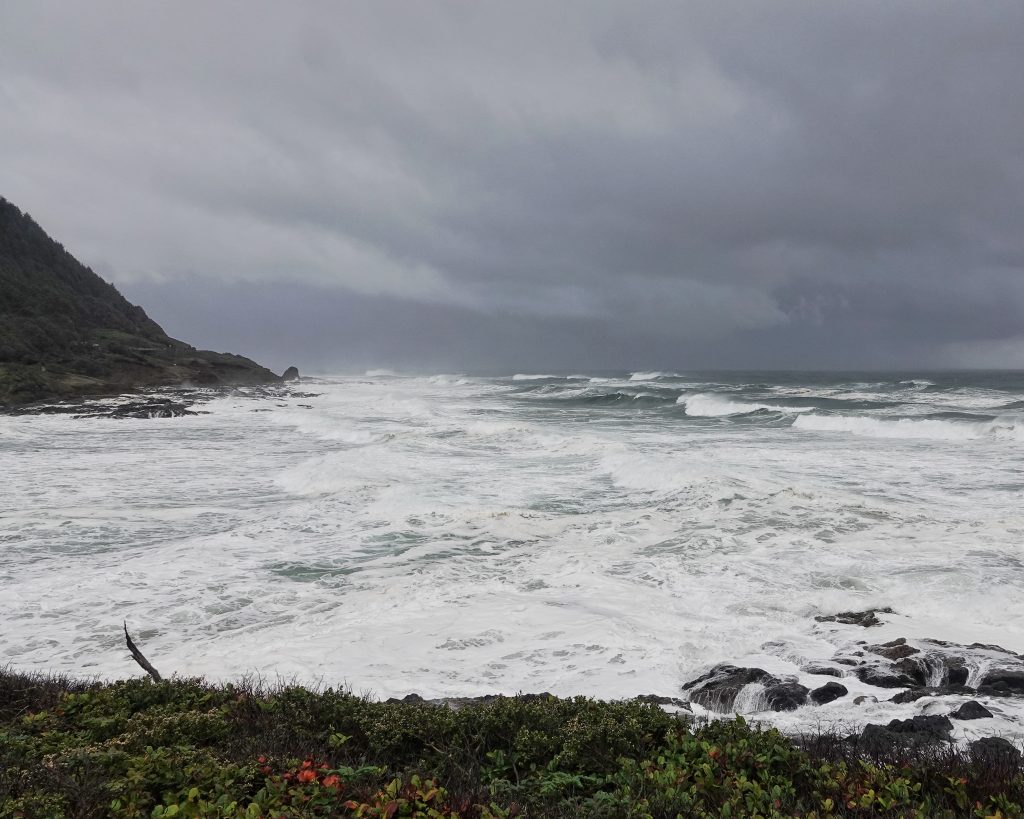
My plan had been to explore the area along the Yachats River, and camp somewhere up there, but when I saw a little paved, one lane road heading up into the Siuslaw National Forest, I took it. After about a mile (and one dicey encounter with another vehicle on that narrow road) I started spotting some camping spots. Unfortunately they were also dumping spots, where people with no respect for the forest had left mounds of garbage. This is a real problem in that area, and two of the best sites actually had abandoned and partially destroyed travel trailers to go with the piles of trash and busted appliances. Even the spot where I did camp, which looked clean from the road, turned out to have mounds of refuse hidden in the brush. But those spots sometimes harbor interesting critters, and I found an Ensatina salamander in one, just before I found about a dozen dirty needles and decided the potential rewards were not worth the risks.
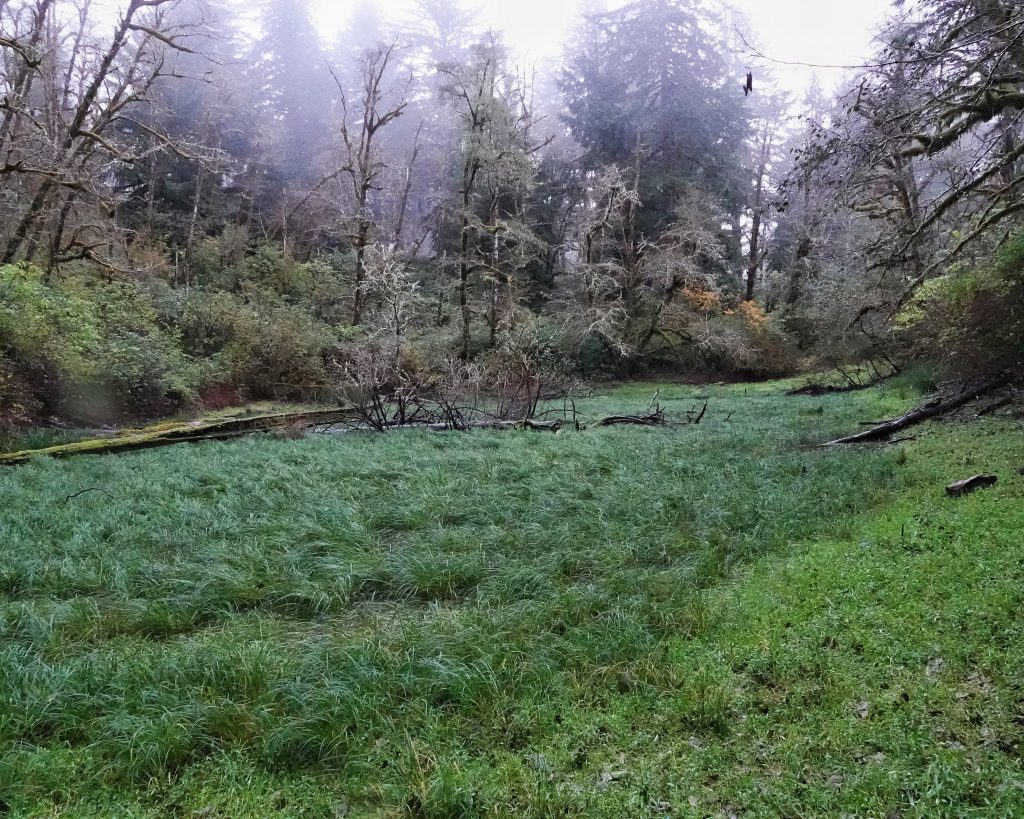
I wandered the area for several hours before setting up camp, both on foot and in my van. The weather moderated to light but steady rain, and I was plenty comfortable in my rain gear, at least until, on a game trail leading from one road to another, I shredded the pants on three different sticks in about two minutes. It was a lovely forest, dominated by western hemlock and Sitka spruce, dark, foggy, and still, but not much wildlife beyond a few juncos and several robins. I ended up at Dry Creek trailhead, which had a nice little wetland with rough-skin newts, and some interesting mosses (that I’ve yet to identify) beyond the usual Hylocomium splendens and Kindbergia oregana and K. praelonga. I decided to eat my dinner of trail mix and string cheese there, and go bug hunting with a headlamp after it got dark. Which was quite pleasant, but not particularly productive, though I did find some as-yet-unidentified spiders and a couple ichneumonid wasps on the outside walls of the outhouse. So I drove back to the campsite, seeing the first deer of the trip in the process, set up camp and went to bed.
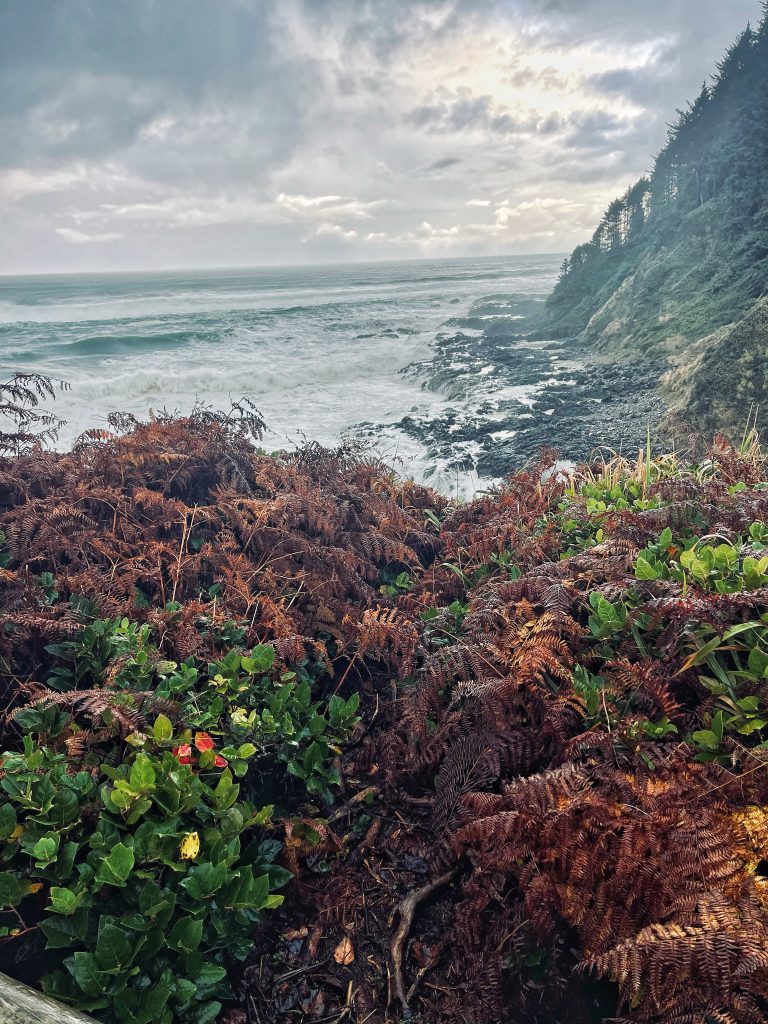
I awoke the next morning to what I at first thought was snow on the ground, but turned out to be probably 3/4” of hail. Surprised I slept through that storm, I guzzled some cold caffeinated beverage, and went to check the road, which was fortunately fairly clear, probably due to it being 3 or 4 degrees above freezing. So I headed back to Hwy 101, and thence north towards Yachats. I stopped at Devils Churn near Cape Perpetua, and, since it was low tide, I went down to check out the tidepools. But the surf was far too rough for that to feel safe, and with the wind and heavy rain, I soon retreated to the shelter of my van, although not before getting photographs of the abundant Polypodium scouleri ferns, and the s Oregon/n California coast endemic shrub Garryana elliptica (coast silk tassel). Just as I got back on the road heading south, a thunderstorm hit, with high winds, hail, and lightning. I ran into these squalls all morning, and some had hail that was nearly dime-sized. Though I didn’t actually see any lightning strikes, there were dozens where the flash and the boom were less than a two count apart, so that even during those times when hail wasn’t pelting down, I was reluctant to leave the insulated-by-tires safety of my van. I did catch a break at Bob Creek Wayside, into which I’d pulled because driving felt dangerous (though I’d have had to stop there regardless, since the name of my trusty steed is Bob), because it briefly cleared off and I was able to find and photograph a pair of Black Turnstones.
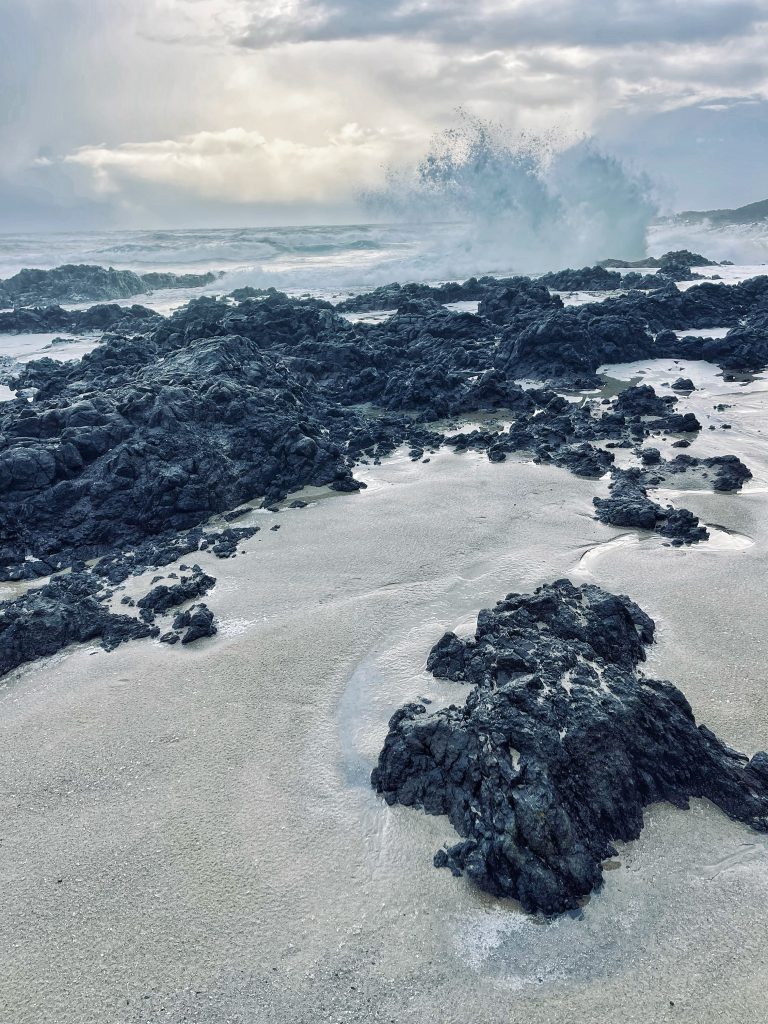
This was the least pleasant day of the trip, and not because of the weather, although that certainly exacerbated the main problem, which was that I somehow hadn’t realized that it was nearly 200 miles from Devils Churn to my planned campsite at Miller Bar on the Chetco River, outside Brookings, Oregon. That is way too much driving in a day for a trip like this, made more problematic by there being only 10 hours of sunlight a day at this time of year. In fact the most important thing I learned about the logistics of a trip like this (even more salient than ‘start with an organized van and keep it organized’, which I didn’t do and which was a source of much frustration), was to limit my daily driving (after a big initial push from home to the area) to no more than 50-60 miles, or maybe 75-90 if I know for sure where I’ll camp and what the situation is there. I got lucky that Miller Bar was easy to find, and as advertised for dispersed camping, because I got there a few hours after dark (partly because I caved in and ate at the McDonalds in Brookings so I wouldn’t be trying to cook in the dark). But the uncertainty still kept me from exploring much on that drive, and meant that my visit to New River Nature Center, a place deserving of at least several hours of focused exploration, was cursory at best.
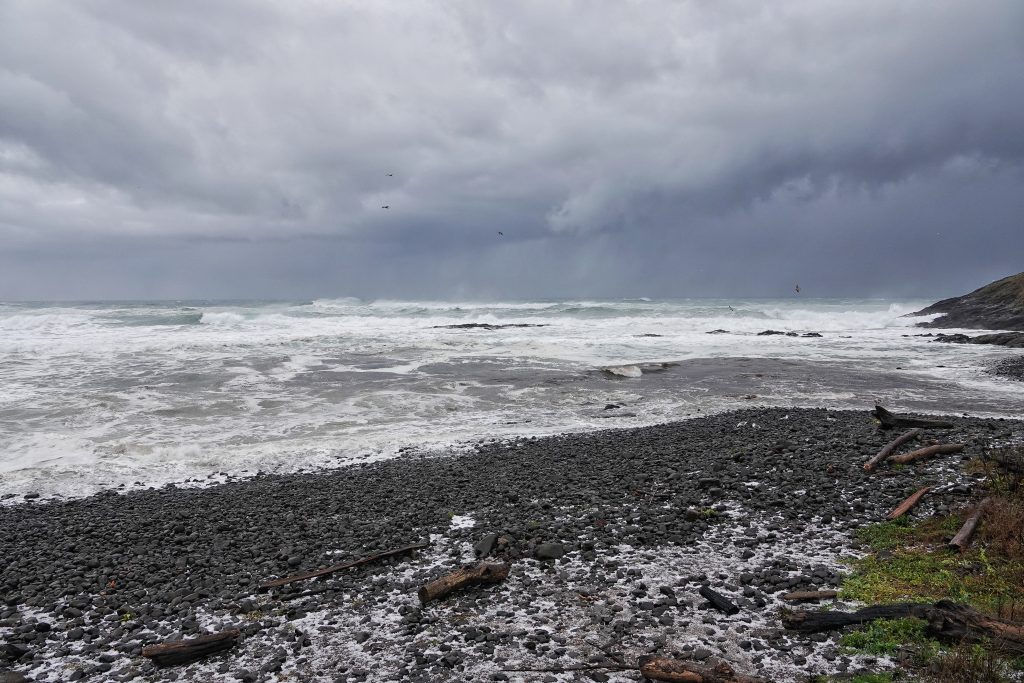
The next day was the best one of the trip, due in large part to the fact that I only drove 34 miles, which allowed me to really explore 2 completely different sites. But that only happened because Steve Sheehy texted me to say that there was no point in driving to Lava Beds because the snow had returned with a vengeance, and because Sam McNally agreed to meet a day later than planned. That left me with a whole day free (the most welcome pivot of the trip!) and I spent half of that exploring the Redwood Nature Trail #1111 near Alfred Loeb State Park, the first redwood forest I’d been in since I was a kid. In addition to the massive redwoods, I also found abundant tanoak and Oregon myrtle, as well as madrones and rhododendrons, and this unusual-to-my-eyes combination of shrubs and trees gave the area a very exotic feel. I also lost my favorite ballcap somewhere on the trail, removed from my head and stuck in my back pocket because I was overheating, but a kind mother and son hiking duo returned it to me about an hour later. Then I was off to visit the tidepools at Lone Ranch Beach, a glorious afternoon of sunshine and sea creatures. I’ll write more about these 2 places when I profile the many living organisms I found there.
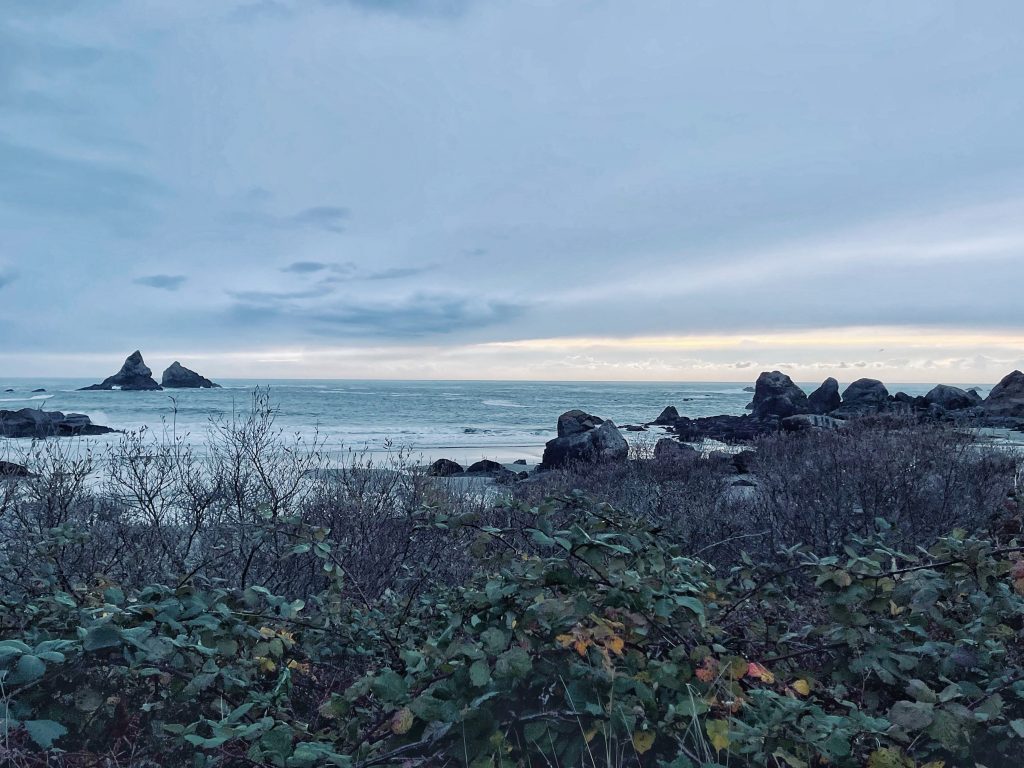
I camped again at Miller Bar, neighbor to only two other parties, who were as quiet and unobtrusive as I could have asked, and I found several beetles as I wandered about with a headlamp, as well as several crayfish in the river. More obtrusive were the fishermen who launched their boat at 5:30 the next morning, but it’s not a quiet process, and I didn’t begrudge them their noise. Besides which I had ground to cover and only a vague idea of where I’d sleep that night, so I just caffeinated myself and headed down the Chetco to Brookings, and south from there towards California. A dawn walk at Crissey Field State Park blew away the last cobwebs in my mind, and though I mostly failed at the game of ‘photograph the seal before it disappears’, still it was exhilarating to watch them hunting. Then back on the road, and suddenly I was in California.
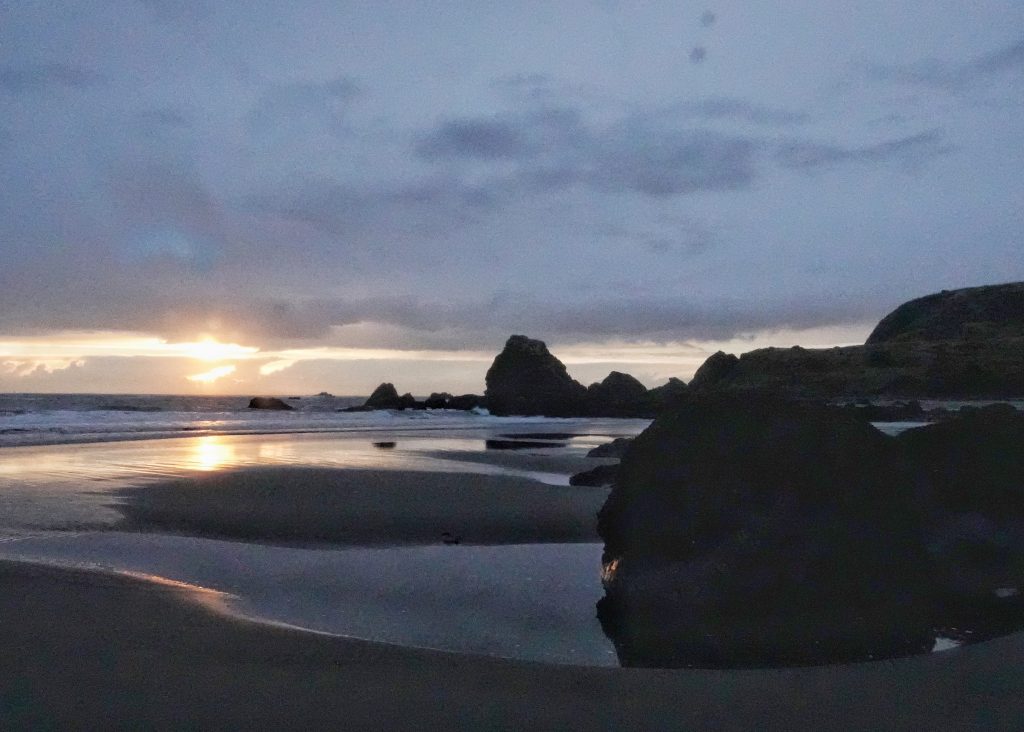
I’m a native Californian, born and raised (till I was 11) in LA County, but I hadn’t been in the state in this century. And it was weird how the whole feel of the landscape changed when I crossed that border. Suddenly, even though there was nothing that could be called a town, there were many more houses, and unlike the whole of the Oregon coast, there didn’t seem to be any public beach access. But there was also a lot more agriculture in the form of large plowed or grassed fields, so maybe it was mostly that the character of the land changed rather abruptly, rather than the character of the government or the people.
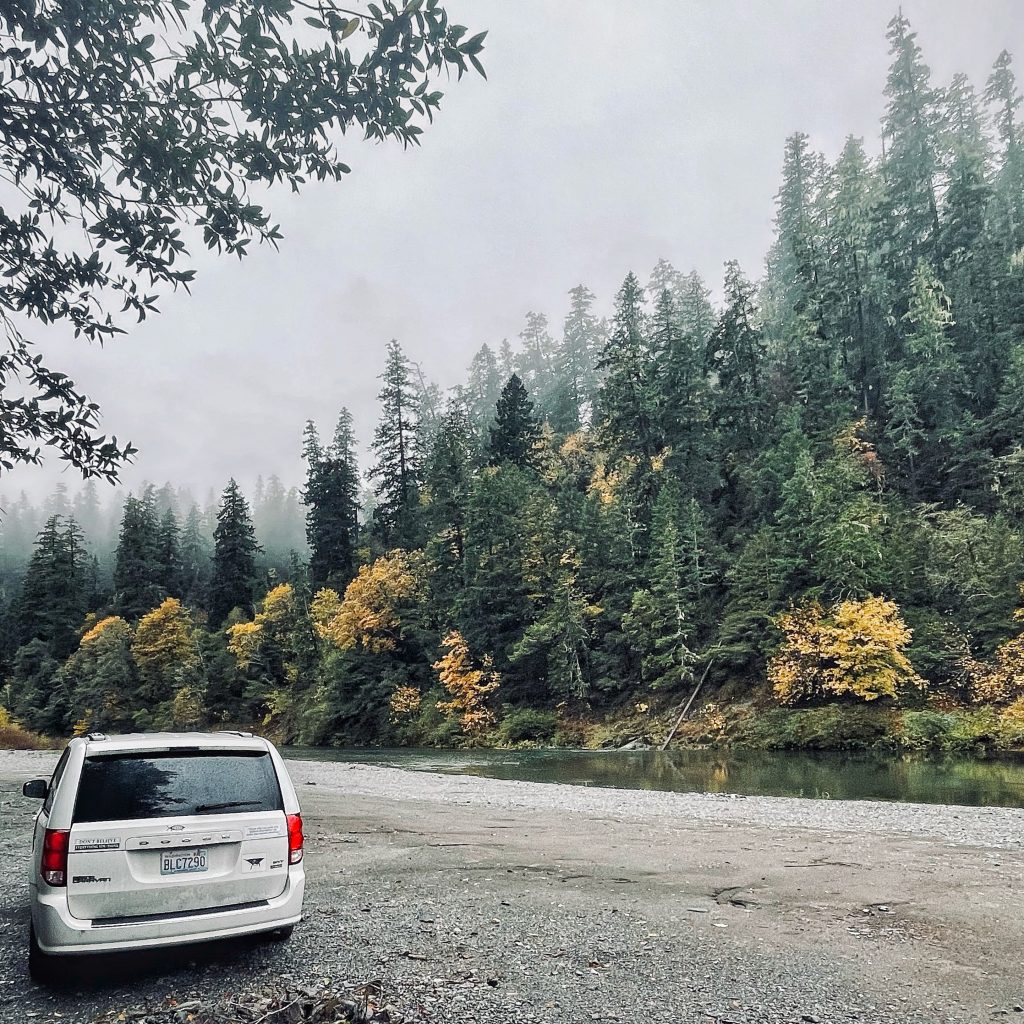
Shortly after Hwy 197 cut off from Hwy 101, I found my first Port Orford Cedar. I stopped and photographed it, and then a couple more a mile or so later, and then a nice clump of them in Jedediah Smith Redwoods State Park, not realizing that, now that I was on Hwy 199 (also known as the Redwood Hwy in Oregon), I was about to enter an area where Port Orford cedar were one of the dominant trees in the landscape. Known as the Smith River National Recreation Area, this 30 mile or so stretch between Jedediah Smith and the Oregon border is spectacular country, with big views of the Klamath Mtns, as it parallels and periodically accesses the main stem Smith, and then the Middle Fork Smith above its confluence with the North Fork Smith to form the main stem. This is an area with much biological diversity, where one could spend many days exploring, but I was again concerned about where I would camp that night, so I limited myself to hiking (well, walking-I’m too easily distracted to hike) the Darlingtonia botanical trail, a sweet little area full of tanoak, Oregon Myrtle, Port Orford and incense cedar, and with a wonderful Darlingtonia (the carnivorous pitcher plant) bog that I’d love to visit in summer to see if it has black petaltail dragonflies. I wandered around at a few more viewpoints, and strolled the river bank in a couple spots, but by mid afternoon I was moving steadily northward, crossing back into Oregon, and finally turning off of Hwy 199 onto the road to Happy Camp, California.
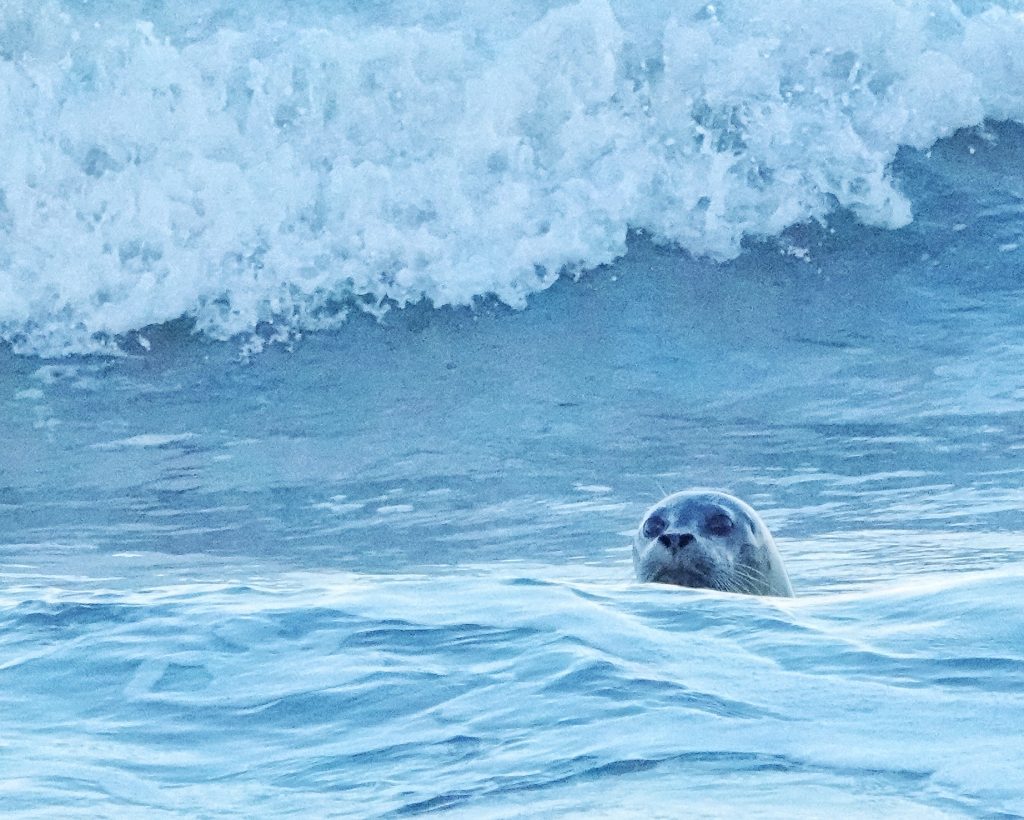
The road goes through a mix of gated BLM land and private property, until it finally gets into the Rogue River- Siskiyou National Forest. There aren’t a lot of good camping spots, at least in the first 6 miles, and after the 4th mile I was into an area that had burned recently enough that there wasn’t much regeneration yet, so that not only was it not aesthetically pleasing, it was depressing as well. And around there I got above 2500’ and started seeing a lot of snow. The plan had been to get up into the higher elevation forests, which I’d read had a great diversity of conifers. And though the road itself was still fine, it is not maintained, and seemed likely to eventually become dicey. I had tire chains, bought especially for this trip, but to my mind they are more of an emergency solution, rather than a go to tool, although that may be just laziness talking. Finally, I pivoted. After about a half mile of driving in a pair of wheel tracks, with 4-5” of snow between them, and afraid I might get someplace where I’d have to back down a lengthy stretch of road, I came to a wide spot in the road and turned around. I think it was the right call, but it was based in fear, and I try not to live my life from fear. On the other hand, a friend just posted a quote from Jeremy Goldberg that says “Courage is knowing it might hurt, and doing it anyway. Stupidity is the same. And that’s why life is hard.”
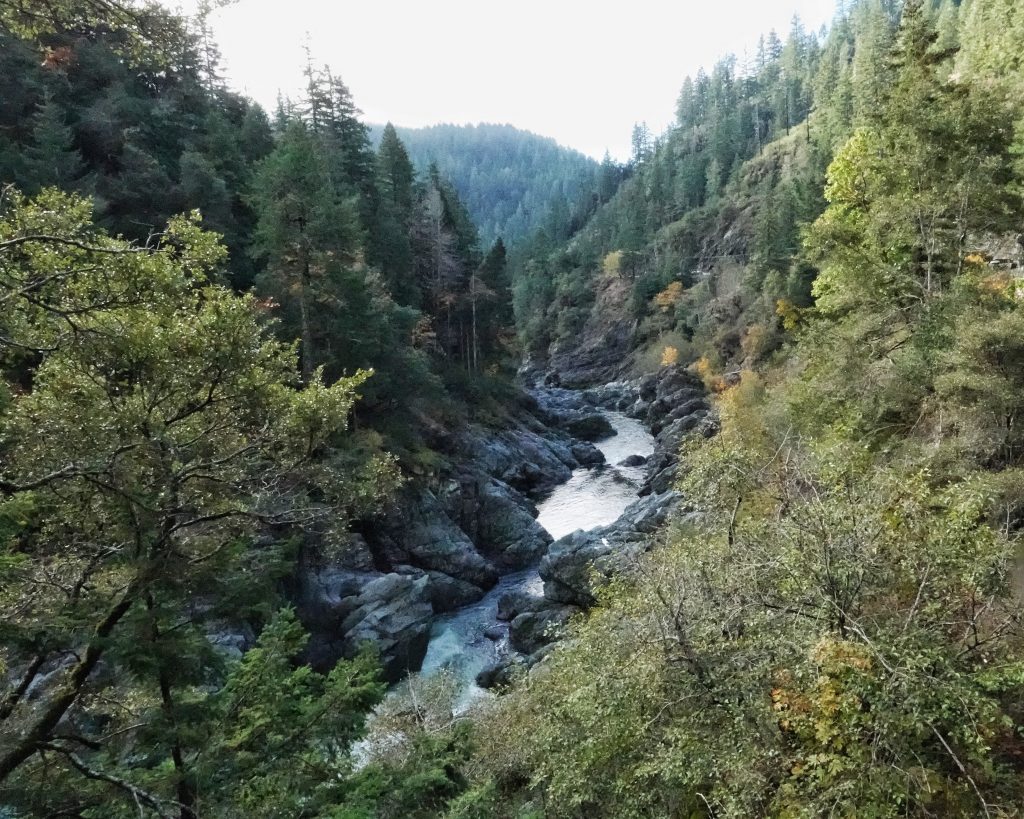
I made camp in the nicest spot I’d seen, the only one where I could get completely off the main road without being at the mouth of another road (once a few years ago in the Gifford-Pinchot NF I was setting up camp at the mouth of what appeared to me to be an impassable road, when suddenly a stripped down jeep came roaring down it and was barely able to stop before crashing into my stuff; the off-roaders were not happy with me and spewed nonstop obscenities as I cleared them a path). Judging by the charred trunks of incense cedar and ponderosa and Jeffrey pines (my first confirmed members of this species) this area had also been burned, but either less recently or less intensely, because there was brush and grass in the understory. Because it wasn’t raining, for the first time on the trip I set up mothing lights whilst cooking dinner, but other than a small caddisfly and several harvestmen, no arthropods came to visit. The best find from that location was a camel cricket in the genus Pristoceuthophilus that was sheltering under a slab of bark on the ground.
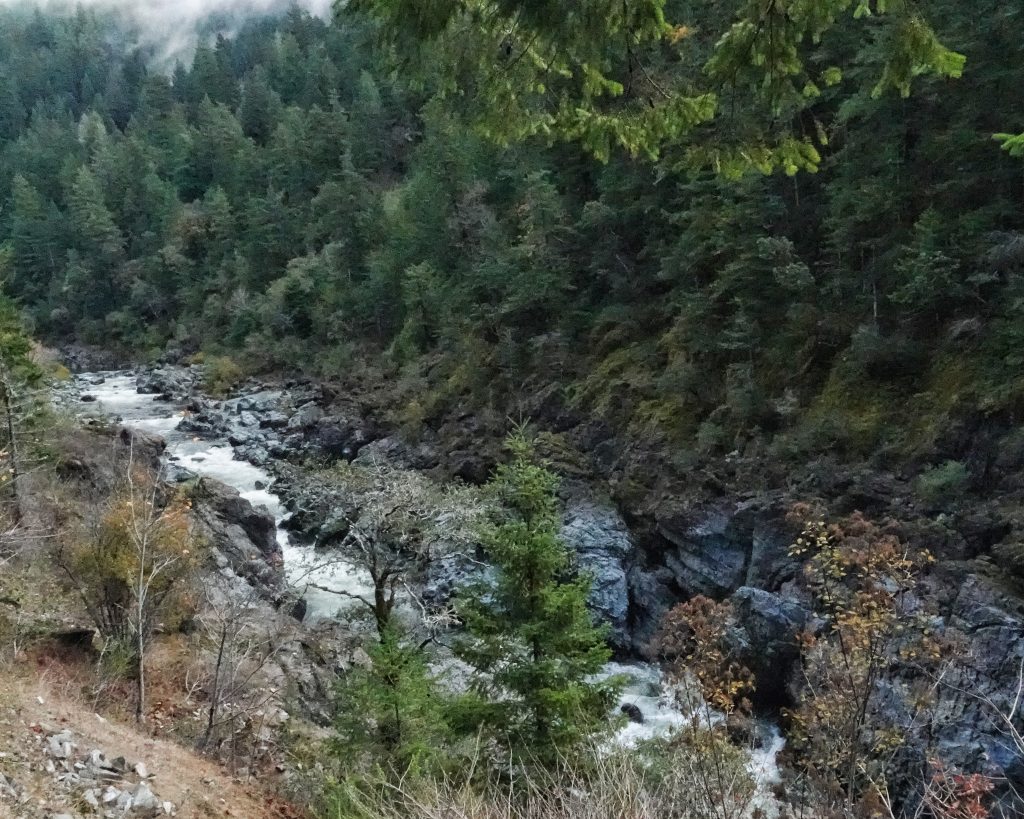
I was up before dawn, mostly because when I awoke the outside world seem especially bright, and I thought it had snowed. The jolt of adrenaline didn’t immediately dissipate once I’d put on my glasses and wiped clean a window to discover that it was bright moonlight on grass that I’d mistaken for snow. For a change I’d been smart enough to make a thermos of tea the night before, so I was grateful for an almost hot caffeinated beverage (this was the coldest morning of the trip with a temperature barely above freezing) as I loaded up the van and hit the road. I was meeting Sam McNally at 10, and I had nearly 90 miles to drive before then, as well as needing to wash up a bit and change out of the clothes that I’d been living in for 5 days. Which I did in a service station bathroom so as not to offend the citizenry, though I did get some dirty looks from a group of construction workers (who obviously met there routinely for pre-work coffee and donuts) while assembling fresh clothing. I believe they thought I was living out of my van, and technically I guess I was, but while they probably assumed I was destitute and shirking my responsibility to society, I knew I was free from my 45 year sentence to the conventions of wage slavery.
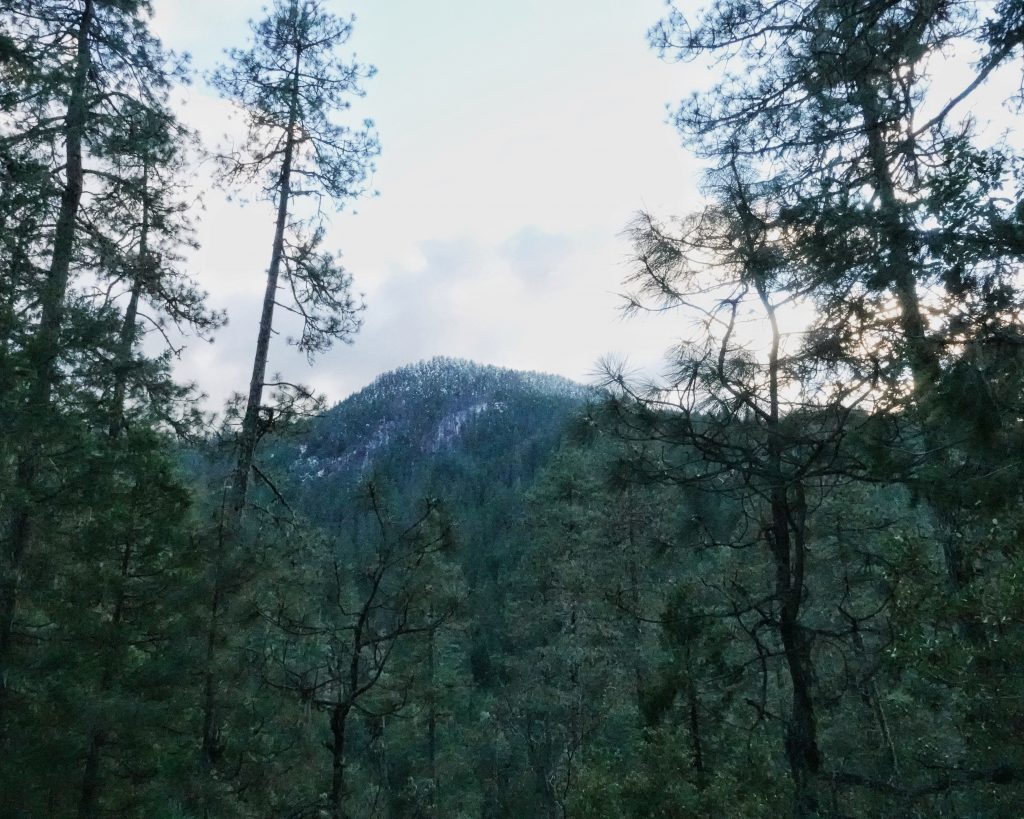
I’d never met Sam before, though we’ve been Facebook friends for a couple years, and he turned out to be a great guy. We headed up into the hills southwest of Medford, to an oak/madrone/pine habitat on the East Applegate Ridge trail, and almost immediately he found some Ischnocybe plicata, very cool millipedes that Sam colloquially calls pinkies, due to their coloration. In fact Sam found dozens, maybe hundreds, of these little millipedes, while I found none. Not a single one, despite examining the undersides of many logs, sticks, and rocks. It was like going herping with Craig Sondergaard. Some people just know where to look. I did find several wood cockroaches, and some other millipedes, but Sam also found the other coolest critters of the day, a juvenile skink, and two northwest forest scorpions (Uroctonus mordax). After a delicious burrito lunch eaten in the sunshine at a park in the little town of Phoenix, Sam directed me back into the hills, though this spot was Doug-fir/alder/maple habitat, where we found several more species of millipedes, a cool little snail I haven’t figured out yet, and an Ensatina. And, as the forest grew darker, I realized I was done for this trip. I had found more than enough interesting living organisms to keep me occupied for weeks, and it was time to leave.
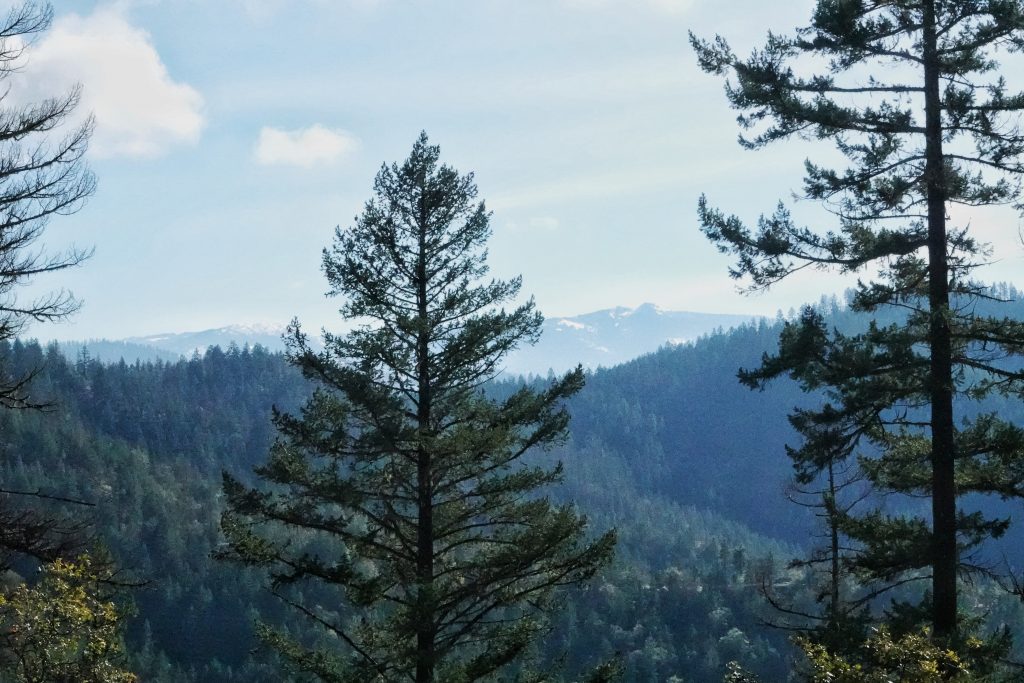
I took Sam home, and texted Pam and my dad to tell them I was heading back. I was beat, and planned to stop and take a nap at a rest area somewhere in the 290 miles between there and Vancouver, but the idea of seeing my wife that night energized me. So I guzzled 20 some ounces of iced tea, cracked open a Mountain Dew, cranked up some rock&roll, and, except for a stop for gas and one to drain my bladder, drove straight on through. As I drove I contemplated the many things I learned on this trip, things about logistics and flexibility that will make the next trip easier, more fun and more efficient. I had discovered that, at my age and in the uncertain and yet highly regulated 21st century, I feel quite vulnerable when I’m in strange country and don’t know a safe, legal place to sleep for the night. I found many living organisms that were new to me, and reacquainted myself with some old friends. And I realized that I don’t need to find everything in one visit, that there is ego and greed involved in a constant search for new things, and that the country and the critters will be there next time, as long as I make it back home this time.
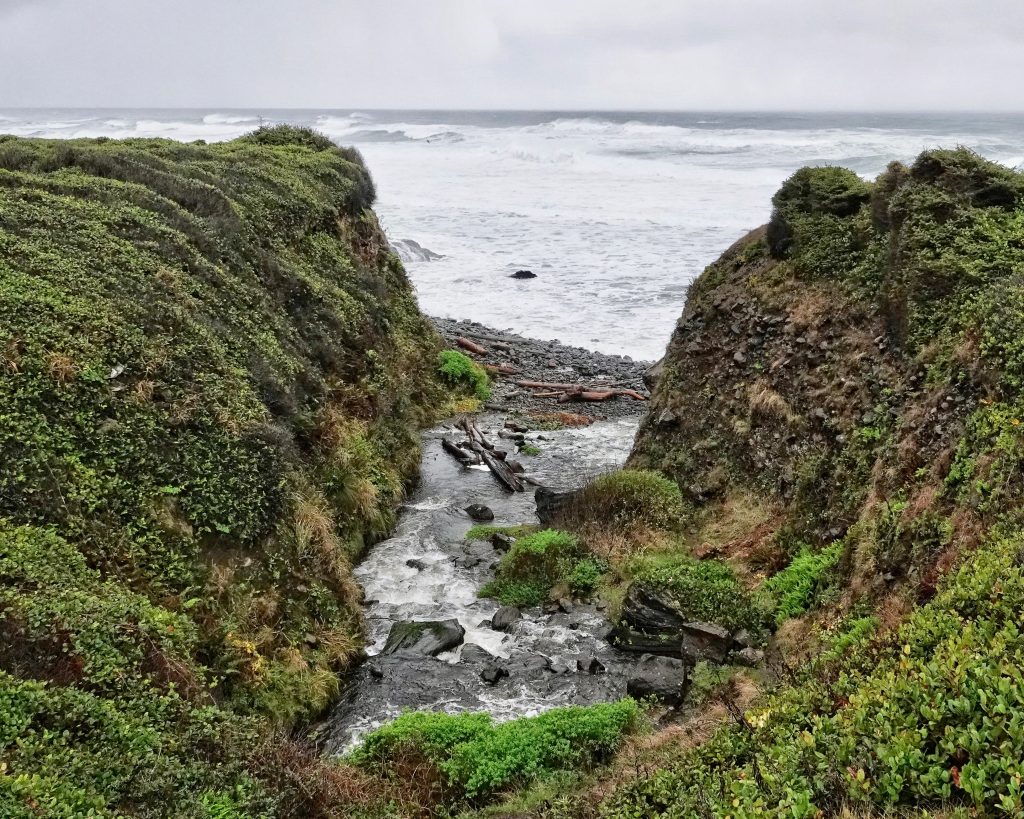
what a wonderful trip, such a magical area… I used to live out there and loved it so much until the health care agency I worked for fell apart and I had to move to find work. I used to walk the beaches every day and after storms so many interesting things washed up – bird skulls, big strong pelican feathers, beautiful rocks. Love the photos! Thank you for sharing it with us!
Thank you for your appreciation, Amanda!
Nice little vicarious road trip in the comfort of my home this a m. Having experienced most similar challenges in a variety of van excursions over the years I read of your trials with both sympathy and amusement. If your ever inclined to bio blitz in the north coast, my partner Deb and I have a modest home in Nehalem with room to park a van without fee or fear. You would be welcome to base camp here and explore the area at will. You might awaken surrounded by elk or your afternoon nap might be disturbed by nesting eagle chatter but you appear to be someone who could overcome these inconveniences. D
Thank you Doug! I will most assuredly take you up on your generous offer! I love that area and have wanted to do an extended exploration there. Thank you!!!
Fantastic post, really interesting!
Thank you for sharing all that!
I was utterly thrilled to find a rough newt in my own small garden this year, as well as at least 3 different looking salamanders. 😁
Thank you for your appreciation, Ilse! If you ever find things and you are not sure of their identity, feel free to send me good photos of them and I’ll see if I can figure out what they might be.
Recreationalnaturalist@10000thingsofthepnw.com
There’s no doubt about it, Dan, even your travelogue writing keeps your readers reading! Don’t forget about BC, OK?
Thanks, Trevor! I really hope to get up there next year.
Dan — Excellent writing and a remarkable trip. I wouldn’t know a tenth of the flora and fauna you found. Good going!
Thank you Vincent! I wish I’d started this 40 years ago, because I really don’t know much beyond a few names. But I am learning!